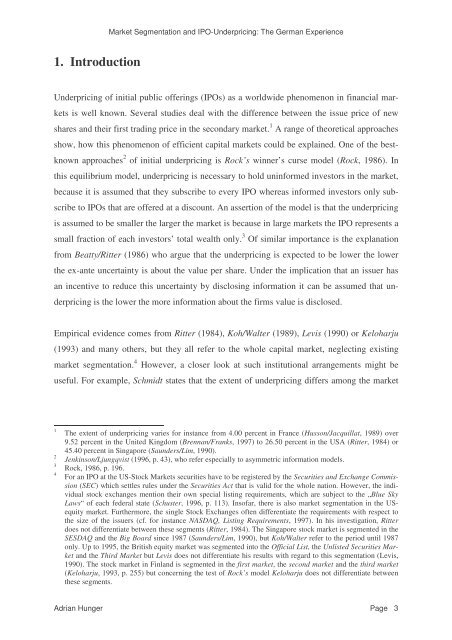Market Segmentation and IPO-Underpricing: The German Experience
Market Segmentation and IPO-Underpricing: The German Experience
Market Segmentation and IPO-Underpricing: The German Experience
Create successful ePaper yourself
Turn your PDF publications into a flip-book with our unique Google optimized e-Paper software.
1. Introduction<br />
<strong>Market</strong> <strong>Segmentation</strong> <strong>and</strong> <strong>IPO</strong>-<strong>Underpricing</strong>: <strong>The</strong> <strong>German</strong> <strong>Experience</strong><br />
<strong>Underpricing</strong> of initial public offerings (<strong>IPO</strong>s) as a worldwide phenomenon in financial mar-<br />
kets is well known. Several studies deal with the difference between the issue price of new<br />
shares <strong>and</strong> their first trading price in the secondary market. 1 A range of theoretical approaches<br />
show, how this phenomenon of efficient capital markets could be explained. One of the best-<br />
known approaches 2 of initial underpricing is Rock’s winner’s curse model (Rock, 1986). In<br />
this equilibrium model, underpricing is necessary to hold uninformed investors in the market,<br />
because it is assumed that they subscribe to every <strong>IPO</strong> whereas informed investors only sub-<br />
scribe to <strong>IPO</strong>s that are offered at a discount. An assertion of the model is that the underpricing<br />
is assumed to be smaller the larger the market is because in large markets the <strong>IPO</strong> represents a<br />
small fraction of each investors’ total wealth only. 3 Of similar importance is the explanation<br />
from Beatty/Ritter (1986) who argue that the underpricing is expected to be lower the lower<br />
the ex-ante uncertainty is about the value per share. Under the implication that an issuer has<br />
an incentive to reduce this uncertainty by disclosing information it can be assumed that un-<br />
derpricing is the lower the more information about the firms value is disclosed.<br />
Empirical evidence comes from Ritter (1984), Koh/Walter (1989), Levis (1990) or Keloharju<br />
(1993) <strong>and</strong> many others, but they all refer to the whole capital market, neglecting existing<br />
market segmentation. 4 However, a closer look at such institutional arrangements might be<br />
useful. For example, Schmidt states that the extent of underpricing differs among the market<br />
1 <strong>The</strong> extent of underpricing varies for instance from 4.00 percent in France (Husson/Jacquillat, 1989) over<br />
9.52 percent in the United Kingdom (Brennan/Franks, 1997) to 26.50 percent in the USA (Ritter, 1984) or<br />
2<br />
45.40 percent in Singapore (Saunders/Lim, 1990).<br />
Jenkinson/Ljungqvist (1996, p. 43), who refer especially to asymmetric information models.<br />
3 Rock, 1986, p. 196.<br />
4 For an <strong>IPO</strong> at the US-Stock <strong>Market</strong>s securities have to be registered by the Securities <strong>and</strong> Exchange Commission<br />
(SEC) which settles rules under the Securities Act that is valid for the whole nation. However, the individual<br />
stock exchanges mention their own special listing requirements, which are subject to the „Blue Sky<br />
Laws“ of each federal state (Schuster, 1996, p. 113). Insofar, there is also market segmentation in the USequity<br />
market. Furthermore, the single Stock Exchanges often differentiate the requirements with respect to<br />
the size of the issuers (cf. for instance NASDAQ, Listing Requirements, 1997). In his investigation, Ritter<br />
does not differentiate between these segments (Ritter, 1984). <strong>The</strong> Singapore stock market is segmented in the<br />
SESDAQ <strong>and</strong> the Big Board since 1987 (Saunders/Lim, 1990), but Koh/Walter refer to the period until 1987<br />
only. Up to 1995, the British equity market was segmented into the Official List, the Unlisted Securities <strong>Market</strong><br />
<strong>and</strong> the Third <strong>Market</strong> but Levis does not differentiate his results with regard to this segmentation (Levis,<br />
1990). <strong>The</strong> stock market in Finl<strong>and</strong> is segmented in the first market, the second market <strong>and</strong> the third market<br />
(Keloharju, 1993, p. 255) but concerning the test of Rock’s model Keloharju does not differentiate between<br />
these segments.<br />
Adrian Hunger Page 3


